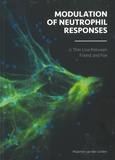Modulation of neutrophil responses
A Thin Line Between Friend and Foe

Linden, Maarten van der
- Promoter:
- Prof.dr. L. (Linde) Meyaard
- Research group:
- Inhibitory receptor lab
- Date:
- March 22, 2018
- Time:
- 12:45 h
Summary
Neutrophils, a type of leukocytes that belongs to the innate immune system, act as the first line of host defense against foreigners during acute infection. Neutrophils have an extensive arsenal necessary to eradicate the enemy, amongst others the release of neutrophil extracellular traps (NETs). NETs are filaments of DNA and histones decorated with antimicrobial peptides and enzymes. NET release contributes to the antimicrobial strategy of neutrophils by trapping bacteria, fungi, viruses and protozoa. Moreover, antimicrobial proteases present in NETs kill these pathogens.
Although NETs are of great value for host defense, NET release must be tightly regulated to prevent pathology because incomplete clearance of NETs injures the host by inducing tissue damage. Antimicrobial peptides and histones present in NETs are highly cytotoxic and damage host cells. Furthermore, NETs impair wound healing in diabetes and play a role in the initiation and progression of several cardiovascular and autoimmune diseases.
The activation of neutrophils needs to be counterbalanced by immune suppression signals to avoid undesirable collateral damage or detrimental inflammation. Neutrophils express the inhibitory receptor Signal Inhibitory Receptor on Leukocytes-1 (SIRL-1). SIRL-1 is an immunoreceptor tyrosine-based inhibition motif (ITIM)-bearing receptor that inhibits Fc receptor-mediated respiratory burst and suppresses spontaneous and anti-LL-37 antibody-induced NET release in SLE and healthy donor neutrophil, respectively.
We aimed to better understand the role of NETs in health and disease and highlight potential NET specific therapeutic treatments, with focus on the inhibitory receptor SIRL-1. We describe a live imaging semi-automated approach to quantify NET release in response to physiological stimuli which allows us to study NET kinetics and the underlying signaling mechanisms of NET release. Subsequently, we used this NET assay to investigate NET release in response to plasma of patients with SLE, SLE + antiphospholipid syndrome (APS) and primary APS in relation to clinical and serological parameters. This provides us additional insight of the role of NETs in SLE and APS in relation to disease activity and immunopathology.
SIRL-1 has been shown to suppress NET release in response to plasma and autoantibodies of SLE patients. To be a potential therapeutic target for pathogenic NETs, it is important to specifically modify NET release without affecting other neutrophil antimicrobial functions. We demonstrate that SIRL-1 is able to limit NET formation in response to other triggers and that intracellular bacterial killing by neutrophils remains preserved upon SIRL-1 ligation. This makes SIRL-1 a potential therapeutic target for treatment of NET-related diseases. However, to fully understand the role of SIRL-1 in immune regulation in health and disease, it is essential to study the interaction of the receptor with its ligand. We describe an endogenous peptide that is able to bind and activate SIRL-1. In addition, bacteria may use inhibitory receptors as immune evasion strategy. We investigate whether secreted peptides from Staphylococcus aureus, closely related to these endogenous peptides, are able to activate SIRL-1.